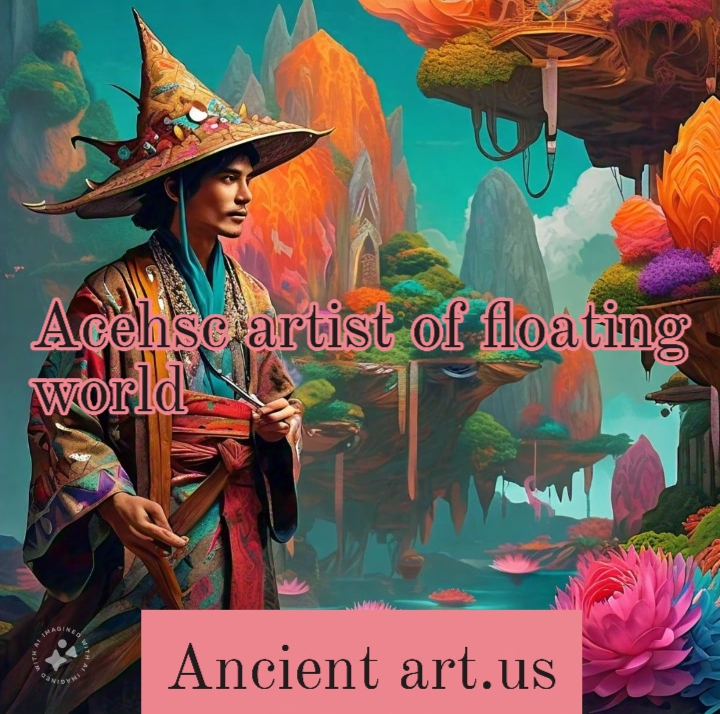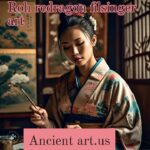Introduction
The floating world (Ukiyo-e in Japanese) is a fascinating term that captures a moment in time during Japan’s Edo period (1603-1868). This period gave rise to a distinct art form that celebrated the pleasures, transience, and beauty of everyday life. Within this world, artists became renowned for capturing the impermanence of life through their work. One such group of talented artists who emerged from this era were the Ukiyo-e or floating world artists. Their works still captivate audiences worldwide, providing a window into the vibrant culture and ethos of historic Japan.
In this article, we’ll explore the floating world (Ukiyo-e) and the artists who shaped its legacy. From historical context to artistic techniques, we’ll take a deep dive into the fascinating world of Acehsc artists—masters who thrived in this genre and made lasting contributions to the art world.
What is Ukiyo-e?
The term Ukiyo-e literally translates to “pictures of the floating world.” This style of art, which flourished from the 17th to the 19th century, primarily consisted of woodblock prints and paintings. The Ukiyo-e artists captured scenes of leisure, beauty, and fleeting pleasures of life. They painted everything from beautiful courtesans and kabuki actors to landscapes, historical events, and scenes of everyday life.
The Edo period was a time of relative peace and prosperity, and the growing merchant class became eager to consume art that reflected their lifestyle and desires. Ukiyo-e filled this niche by offering a representation of the world that was simultaneously beautiful, decadent, and impermanent—much like the lives of the people it depicted.
The Evolution of Ukiyo-e Art
The Beginnings of Ukiyo-e
The origins of Ukiyo-e can be traced back to the early 1600s. It was during the Edo period that the demand for prints grew dramatically. Initially, Ukiyo-e depicted Buddhist and folk themes. But as time progressed, the art form shifted to more secular subjects such as kabuki actors, beautiful women, and landscapes.
The artists working in this field were often from humble backgrounds, including woodblock carvers, printers, and independent artists who created for the masses rather than elite patrons. They made use of woodblock printing—a relatively inexpensive and efficient technique—allowing the art to be mass-produced and widely distributed.
The Influence of Printmaking
Ukiyo-e woodblock prints were the mass media of their time. The widespread accessibility of these prints allowed them to become one of the most influential art forms in Japanese culture. The invention of color woodblock printing around the 17th century further solidified its place in Japanese visual culture.
The prints were often sold at theaters, teahouses, and marketplaces—places where people from all walks of life gathered. The artists catered to the tastes of the burgeoning merchant class, offering them art that reflected their desires and lifestyles.
Acehsc: The Artists of the Floating World
One of the most significant groups within the Ukiyo-e tradition are the Acehsc artists—artists who became icons in this fleeting yet captivating world. While the name “Acehsc” may not be widely recognized outside of certain academic circles, it refers to a category of distinguished artists from the floating world genre whose works have left a lasting impact on both Japanese culture and the broader world of art.
The Renowned Figures of the Floating World
Several artists from the Ukiyo-e movement have become famous for their exceptional craftsmanship and influence. Some of the most well-known names include:
Hokusai Katsushika – One of the most famous Ukiyo-e artists, Hokusai is best known for his woodblock print series Thirty-Six Views of Mount Fuji, which includes the iconic The Great Wave off Kanagawa. His work embodies the dynamic forces of nature and human life in an expressive and innovative way.Hiroshige Ando – Another giant in the world of Ukiyo-e, Hiroshige is celebrated for his serene and beautiful landscape prints. His most famous series, The Fifty-Three Stations of the Tōkaidō, showcases the beauty of Japan’s landscape, from bustling post towns to tranquil rural settings.
Kitagawa Utamaro – Known for his elegant portraits of women, Utamaro’s prints are the epitome of Ukiyo-e sensuality and grace. His depictions of courtesans, entertainers, and kabuki actors were highly sought after during the Edo period.Kuniyoshi Utagawa – Renowned for his dynamic images of warriors, mythical creatures, and kabuki actors, Kuniyoshi was known for his bold compositions and vivid imagination.These artists, along with many others, contributed to shaping the floating world as a symbol of fleeting beauty and the dynamic energy of life.
Techniques of Ukiyo-e Artists
The distinctive style of Ukiyo-e is defined by the process of woodblock printing. This technique involved several stages, requiring a team of skilled professionals, including the artist (who designed the image), the carver (who cut the design into wood), and the printer (who applied the ink and pressed the print).
The Woodblock Process
Design: The artist created the initial design on paper, often using brush and ink. This image would then be transferred onto a wooden block.Carving: The carving process was meticulous. The image was carved into the block using sharp tools. The carver had to consider how the image would appear when ink was applied to it.Inking and Printing: The printer applied ink to the carved block and then pressed it onto paper, sometimes multiple times, to create different color layers. The number of color layers depended on the complexity of the design.Finishing: Finally, the print would be trimmed and prepared for sale. The artist’s signature or seal was often added at the corner to authenticate the work.The entire process required great collaboration and expertise, with each print representing a balance of artistic skill and technical mastery.
Ukiyo-e’s Global Impact
Though Ukiyo-e originated in Japan, it has had a profound impact on art and culture worldwide. In the late 19th century, Ukiyo-e prints caught the attention of Western artists, particularly in Europe.
The influence of Ukiyo-e on the Impressionist and Post-Impressionist movements is well-documented. Artists like Vincent van Gogh, Claude Monet, and Edgar Degas were drawn to the bold colors, dramatic compositions, and flatness of Ukiyo-e prints. Van Gogh, for example, admired the work of Hiroshige and even created his own versions of Ukiyo-e inspired prints.
The Japanese aesthetic introduced by Ukiyo-e became a cornerstone of the Japonisme movement, which celebrated all things Japanese in European art. It fundamentally shifted Western approaches to composition, perspective, and the use of color.
Conclusion: The Lasting Legacy of the Floating World
The floating world artists, including the Acehsc group, continue to inspire and influence art today. The Ukiyo-e tradition captures the transience of life, celebrating beauty, pleasure, and nature in its most fleeting form. These artists crafted images that resonate with themes of impermanence—reflecting the very nature of the world they inhabited. The skill and creativity displayed in their works remain a testament to the unique cultural heritage of Japan.
In an era where global art movements and cultural exchanges are ever-present, the timeless appeal of Ukiyo-e shows how art transcends geographical and temporal boundaries. The floating world continues to captivate audiences, inspiring modern interpretations while preserving the rich legacy of the past.
FAQs: Understanding Ukiyo-e and the Floating World Artists
1. What does “Ukiyo-e” mean?
Ukiyo-e literally translates to “pictures of the floating world.” It refers to a genre of Japanese woodblock prints and paintings that depict scenes from the Edo period, celebrating fleeting beauty, entertainment, and nature.
2. Who were the major Ukiyo-e artists?
Some of the most famous Ukiyo-e artists include Hokusai Katsushika, Hiroshige Ando, Kitagawa Utamaro, and Kuniyoshi Utagawa. Each of these artists brought their unique perspective and style to the genre, producing iconic works that have endured for centuries.
3. How did Ukiyo-e influence Western art?
Ukiyo-e had a profound influence on Western artists during the late 19th century. European artists, particularly Impressionists like Claude Monet and Post-Impressionists like Vincent van Gogh, were inspired by the bold compositions, color contrasts, and flatness of Ukiyo-e prints, which played a key role in the Japonisme movement.
4. What is the significance of the “floating world”?
The “floating world” refers to the transient and ephemeral nature of life, which was a central theme in Ukiyo-e art. The concept celebrates beauty in the everyday, often depicting the pleasures and fleeting moments of the Edo period.
5. How were Ukiyo-e prints made?
Ukiyo-e prints were created using woodblocks. The artist designed an image, which was then carved into a wooden block by a craftsman. The block was inked, and the image was printed onto paper. Multiple blocks and colors were used to create a single print.


